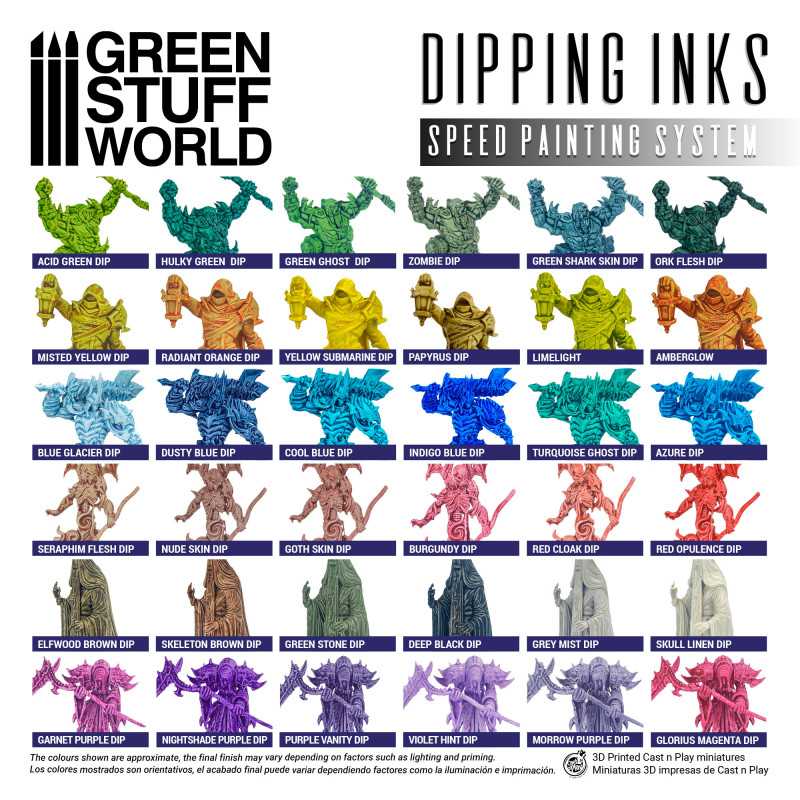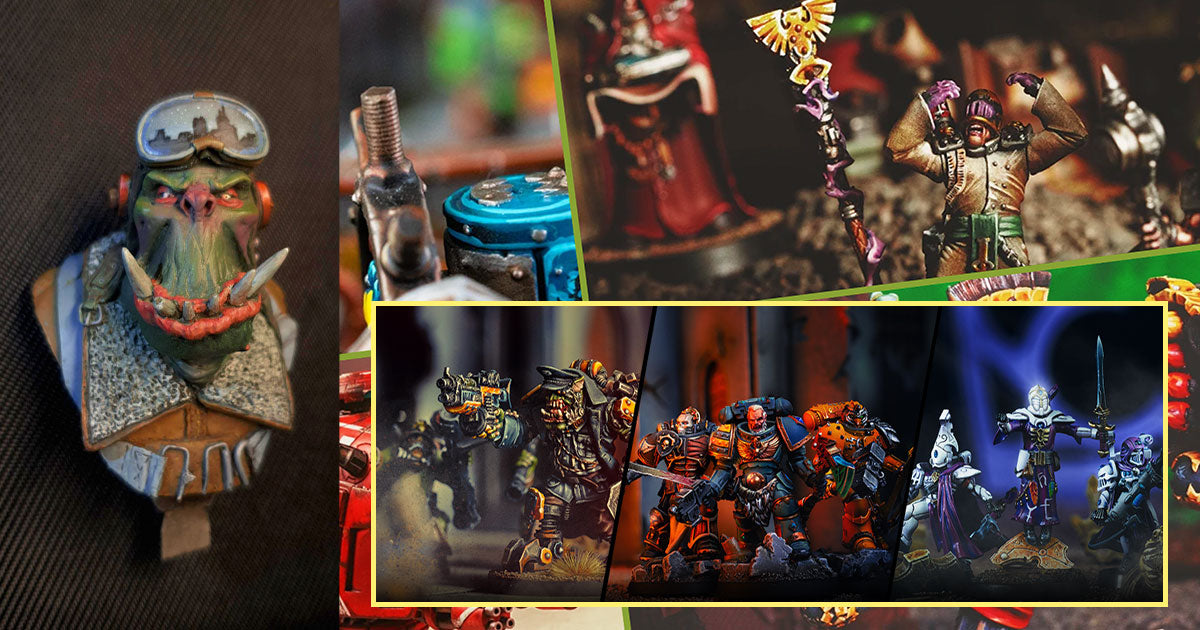Using Washes and Inks to Enhance Your Miniatures
Master the art of depth and detail in miniature painting with essential techniques
Ready to take your miniature painting to the next level? The secret lies in mastering washes and inks - the magical tools that transform ordinary models into extraordinary masterpieces. Whether you're bringing life to character miniatures, enhancing wargaming figures, or perfecting scale models, these techniques are your gateway to achieving professional-quality results that will make your collection truly stand out.
| Essential Guide to Washes & Inks | |
|---|---|
| Fundamentals | Understanding wash and ink properties, selecting the right products for your needs |
| Application Methods | Step-by-step techniques using proper tools and brushes |
| Advanced Techniques | Mastering layering, blending, and creating custom effects |
| Troubleshooting | Common challenges and expert solutions for perfect results |
| Maintenance | Proper care of your painting supplies and workspace |
What Are Washes and Inks?

In the world of miniature painting, washes and inks serve as essential tools for creating depth and dimension that transform simple models into captivating pieces of art. These specialized painting products each serve unique purposes in achieving professional-quality results. Understanding their distinct properties and applications is crucial for mastering the art of miniature painting.
Washes Explained
Washes are thin, fluid solutions designed to flow into recesses and create natural shadows. These versatile products contain finely-ground pigments suspended in a medium that ensures smooth application and consistent results. When applied correctly, washes enhance the model's natural depth by darkening crevices while leaving raised areas untouched.
Understanding Inks
Inks offer intense, concentrated colour with exceptional transparency. Unlike washes, inks provide vibrant tints and can be used for both shading and glazing techniques. Their high pigment concentration makes them perfect for creating rich, deep shadows and subtle colour transitions in your miniature models.
"The key to mastering washes and inks lies in understanding their flow properties and learning to control their application. These tools can either make or break your paintwork, so taking the time to learn proper techniques is essential."
Choosing the Right Supplies
Essential Tools for Success
Quality Brushes
Invest in dedicated washing brushes with good water retention and fine tips. Look for sizes 1-2 for general washing and 0-00 for precise detail work.
Premium Washes
Choose high-quality wash products from reputable manufacturers. Options include army painters, specialized shade paints, and custom-mix solutions.
Supporting Materials
Stock up on essentials like palette wells, mixing mediums, and clean-up supplies to ensure smooth application processes.
Application Techniques
Step-by-Step Application Process
- Surface Preparation: Ensure your model is properly primed and base-coated with quality paints. A smooth basecoat is crucial for wash application.
- Wash Application: Load your brush generously and apply the wash, allowing it to naturally flow into recesses. Work in sections to maintain control.
- Control and Direction: Guide the wash using your brush angle and gravity. Avoid pooling by wicking away excess with a clean, damp brush.
- Layering: Build up intensity gradually with multiple thin layers rather than one thick application. Allow each layer to dry completely.
- Refinement: Clean up any mistakes with your base colour and add highlights where needed using detail brushes.
Pro Tip: Temperature Matters
Work in a room-temperature environment to ensure optimal flow and drying time. Extreme temperatures can affect wash behaviour and final results.
Quick Fix
Keep a clean, damp brush ready to quickly correct any mistakes or control wash flow before it dries.
Advanced Tips and Tricks
For those ready to elevate their miniature painting skills, mastering advanced techniques with washes and inks opens up a world of creative possibilities. These sophisticated methods can transform your models from good to extraordinary, adding nuanced details and professional-quality finishing touches.
Glazing Techniques
Create smooth colour transitions by applying multiple thin layers of diluted washes. Build up intensity gradually for subtle, realistic shading effects.
Targeted Shading
Use fine detail brushes to apply washes precisely in specific areas, creating controlled shadows and depth.
Colour Mixing
Experiment with mixing different paint colours and washes to create unique shading effects and atmospheric tones.
Common Mistakes and Solutions
| Challenge | Solution | Prevention Tips |
|---|---|---|
| Tide Marks | Feather edges with a clean, damp brush | Apply thinner, controlled layers |
| Uneven Coverage | Build up multiple thin layers | Maintain consistent dilution |
| Excessive Pooling | Use a clean brush to wick away excess | Control wash quantity on brush |
Expert Tips for Better Results
Temperature Control
Work in a controlled environment between 18-24°C (65-75°F) for optimal drying times and wash behaviour.
Brush Care
Clean your brushes thoroughly between applications to prevent contamination and maintain precise control.
Care and Maintenance
Tool Maintenance
- ✓ Clean brushes immediately after use with proper cleaning solutions
- ✓ Store brushes horizontally or bristles-up
- ✓ Use brush soap monthly for deep cleaning
Product Storage
- ✓ Keep washes and inks in airtight containers
- ✓ Store away from direct sunlight
- ✓ Check consistency before each use
Create a maintenance schedule for your tools and supplies. Regular care prevents issues and extends the life of your painting equipment, ensuring consistent results in your miniature painting projects.
Frequently Asked Questions
How do I prevent wash from pooling on flat surfaces?
To prevent wash pooling, try these techniques:
- Use less wash on your brush for better control
- Work in smaller sections to maintain control over the flow
- Keep a clean, damp brush ready to wick away excess wash
- Tilt your model while applying to guide the wash into recesses
- Consider using targeted washing instead of all-over application
What's the difference between washes and inks?
Washes are specifically designed to flow into recesses and create shadows, with a more matte finish and subtle tinting effect. Inks are more concentrated, providing intense color and can be used for both shading and glazing. Inks typically have a glossier finish and stronger tinting strength than washes.
How do I fix mistakes when applying washes?
To correct wash application mistakes:
- Quickly remove excess with a clean, damp brush while still wet
- Once dry, carefully layer your base color over unwanted wash areas
- Use targeted highlights with your base paints to restore lost definition
- For stubborn mistakes, consider using a matte medium to help blend corrections
- Always test wash density on a test surface before applying to your model
Can I create my own washes?
Yes, you can create custom washes by diluting regular acrylic paints with water and a flow improver or medium. Add a drop of dish soap to improve flow characteristics. However, commercial washes often provide more consistent results and better flow properties for beginners.
Conclusion
Mastering washes and inks is a transformative step in your miniature painting journey. These versatile tools can elevate your miniatures from basic painted models to stunning pieces with depth, contrast, and professional-quality finishing. By understanding the proper application techniques, choosing the right tools, and practicing these essential skills, you'll be well-equipped to achieve remarkable results in your painting projects.
Remember that patience and practice are crucial when working with washes and inks. Start with simple applications on less important models, gradually building your confidence and technique. Keep your brushes clean, your workspace organized, and don't be afraid to experiment with different techniques and combinations.
Final Thoughts:
Whether you're shading your first miniature or perfecting advanced techniques, washes and inks are indispensable tools in your painting arsenal. With the knowledge and techniques covered in this guide, you're ready to take your miniature painting to new heights. Keep exploring, refining your skills, and most importantly, enjoy the creative process of bringing your models to life.
 is here! Shop now, pay later in 4 easy installments
is here! Shop now, pay later in 4 easy installments

